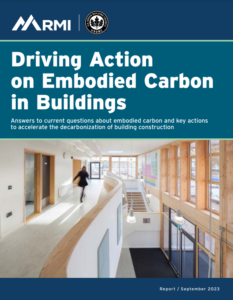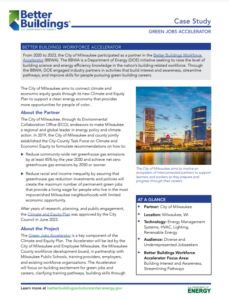The OurEnergyLibrary aggregates and indexes publicly available fact sheets, journal articles, reports, studies, and other publications on U.S. energy topics. It is updated every week to include the most recent energy resources from academia, government, industry, non-profits, think tanks, and trade associations. Suggest a resource by emailing us at info@ourenergypolicy.org.
Resource Library
11 to 20 of 342 item(s) were returned.
From 2020 to 2023, RCC Center for Smart Building Technology participated as a partner in the Better Buildings Workforce Accelerator (BBWA). The BBWA is a Department of Energy initiative seeking to raise the level of building science and energy efficiency knowledge in the nation’s building-related workforce. Through the BBWA, DOE engaged industry partners in activities that build interest and awareness, streamline pathways, and improve skills for people pursuing green building careers. …
View Full ResourceFrom 2020 to 2023, Elevate participated as a partner in the Better Buildings Workforce Accelerator (BBWA). The BBWA is a Department of Energy initiative seeking to raise the level of building science and energy efficiency knowledge in the nation’s building-related workforce. Through the BBWA, DOE engaged industry partners in activities that build interest and awareness, streamline pathways, and improve skills for people pursuing green building careers.…
View Full ResourceRMI’s report We Can Cut Petrochemicals Use Today: Buildings provides an overview of the use of petrochemicals in the construction and renovation of buildings in the United States and what steps can be taken to lower buildings’ embodied emissions based on petrochemical use efficiency.
Most building material efficiency efforts focus on reducing concrete and steel use; however, buildings’ walls, floors, insulation, and siding use an outsized portion of global commodity plastics and other key petrochemicals.
This report details the actions decision makers should prioritize to lower buildings’ embodied emissions due to petrochemical use and thereby mitigate health, fossil-resource, and carbon …
View Full ResourceBuilding decarbonization requires collective industry action: forerunners are already demonstrating what is possible, but we need more leaders to push the boundaries to scale up swift and deep decarbonization. The industry is poised to make this leap, and there are substantial emissions reductions available today that are well within reach. Tools and guidance are widely available, low-hanging fruit have been identified, and new policies are creating greater market certainty. It is time for everyone to get on board to reduce embodied carbon. This report shows you how to get started.…
View Full ResourceFrom 2020 to 2023, the City of Milwaukee participated as a partner in the Better Buildings Workforce Accelerator (BBWA). The BBWA is a Department of Energy (DOE) initiative seeking to raise the level of building science and energy efficiency knowledge in the nation’s building-related workforce. Through the BBWA, DOE engaged industry partners in activities that build interest and awareness, streamline pathways, and improve skills for people pursuing green building careers.…
View Full Resource“Renewable Gas: Not A Climate-Aligned Solution for Buildings” covers biogas and synthetic gas and why neither are viable alternatives to building electrification.
Electrification is the most viable option to fully decarbonize Ohio’s buildings. Alternative fuels like renewable gas are more expensive, limited in supply, and can still cause significant environmental and health impacts. Ohio must
plan to transition away from existing gas infrastructure as part of its clean energy strategy.…
“Renewable Gas: Not A Climate-Aligned Solution for Buildings” covers biogas and synthetic gas and why neither are viable alternatives to building electrification.
Electrification is the most viable option to fully decarbonize Michigan’s buildings. Alternative fuels like renewable gas are more expensive, limited in supply, and can still cause significant environmental and health impacts. Michigan must plan to transition away from existing gas infrastructure as part of its clean energy strategy.…
“Renewable Gas: Not A Climate-Aligned Solution for Buildings” covers biogas and synthetic gas and why neither are viable alternatives to building electrification.
Electrification is the most viable option to fully decarbonize Nevada’s buildings. Alternative fuels like renewable gas are more expensive, limited in supply, and can still cause significant environmental and health impacts. Nevada must plan to transition away from existing gas infrastructure as part of its clean energy strategy.…
“Renewable Gas: Not A Climate-Aligned Solution for Buildings” covers biogas and synthetic gas and why neither are viable alternatives to building electrification.
Electrification is the most viable option to fully decarbonize Oregon’s buildings. Alternative fuels like renewable gas are more expensive, limited in supply, and can still cause significant environmental and health impacts. Oregon must plan to transition away from existing gas infrastructure as part of its clean energy strategy.…
“Renewable Gas: Not A Climate-Aligned Solution for Buildings” covers biogas and synthetic gas and why neither are viable alternatives to building electrification.
Electrification is the most viable option to fully decarbonize New York’s buildings. Alternative fuels like renewable gas are more expensive, limited in supply, and can still cause significant environmental and health impacts. New York must plan to transition away from existing gas infrastructure as part of its clean energy strategy.…









